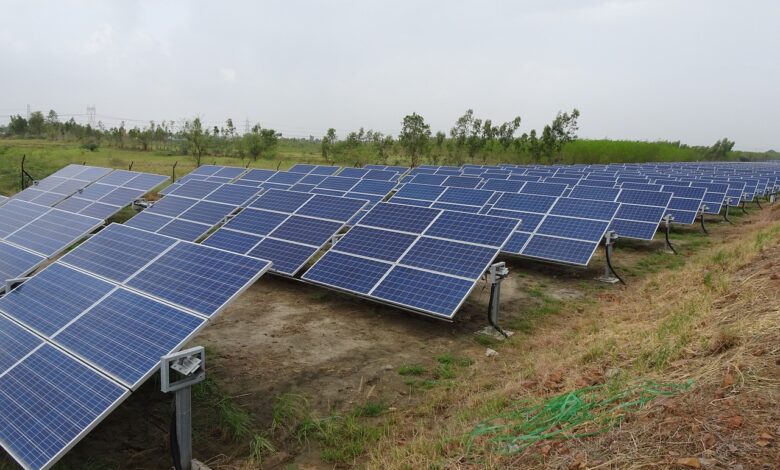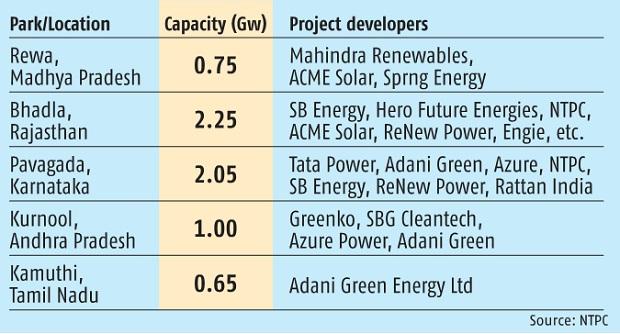With NTPC all set to construct India’s largest solar park in Gujarat, the future of India’s Renewable Energy sector looks promising.
According to records, presently NTPC’s total installed generation capacity is 66 GW. Out of 66 GW, thermal (gas+coal) stands at 61 GW, hydro generates 3.7 GW, solar power supplies 1 GW and the remaining is supplied by wind energy.

National Thermal Power Corporation Limited (NTPC), India’s largest power generator is gearing up to build the country’s largest single local solar power park with a capacity of 4.75 GW.
The project will be undertaken by NTPC’s renewable energy branch in Kutch, Gujarat. The Ministry of New and Renewable energy has given its approval to NTPC Renewable Energy (NTPC-REL), according to the company’s officials. NTPC-REL also plans to utilize this landmark project to produce green hydrogen as well. Kutch in Gujarat is the largest salt desert in India. Two of India’s largest coal-fired power plants are already located in Kutch, the upcoming project will add to its glory.
According to the company, NTPC-REL received the approval under Mode 8 (Ultra Mega Renewable Energy Power Park) of the Solar Park Scheme. The company aims at building 60 GW of Renewable Energy Capacity by the end of 2032. Presently, India has five fully functional solar power parks. Among the world’s largest single-location solar plants, Bhadla in Rajasthan (capacity 2.2 GW) and Pavgada in Karnataka (capacity 2.05 GW) are two of them. The first solar power park of the country was set up in the Rewa district of Madhya Pradesh, with a capacity of 0.75 GW and fully commissioned in 2019.
According to records, presently NTPC’s total installed generation capacity is 66 GW. Out of 66 GW, thermal (gas+coal) stands at 61 GW, hydro generates 3.7 GW, solar power supplies 1 GW and the remaining is supplied by wind energy. In October 2020, the company included a completely-owned subsidiary for its clean energy projects.
The chairman and managing director of the company, Mr Gurdeep Singh in a press conference shared the futuristic goals of the company of adding 7-8 GW of renewable energy every year. He also expressed that the company soon wants to go on the public for raising funds. NTPC is also looking forward to investing in green hydrogen and green methanol that are manufactured at facilities powered by renewable energy.
Solar Parks and Ultra Mega Solar Power Projects scheme
The Ministry of New and Renewable Energy (MNRE) announced the addition of a new mode (Mode 8) in its existing regulations for the implementation of the new scheme for the ‘Development of Solar Power Projects.’ This move came in 2014-15 when the government set new targets of achieving 20 GW capacity by 2020 under solar parks or ultra-mega solar power projects. Earlier this year, the targeted year was extended for another five years. Under this plan, the ministry extends Central Financial Assistance to private players.
Solar Energy Corporation of India (SECI) is the nodal authority for the development of solar power parks in the country. The solar parks provide appropriate developed land with all approvals, access to water supply, communication network, transmission system and road connectivity among others. The scheme smoothens the official processes and reduces the time for the installation of grid-connected solar power projects for generating electricity on a substantial scale.

Presently NTPC constructs renewable generation capacity through two courses: builds the project itself or grants the capacity to private companies. In the case of Kutch, NTPC will build the park itself and grant capacity to private players who would set up generation units. In Kurnool, Andhra Pradesh the company already has a solar park of 0.65 GW capacity. In 2017 it was fully commissioned after the capacity was granted to several private developers.

The government of Gujarat has designated the Kutch region for developing a hybrid renewable energy project of a capacity of 40 GW. The government has already reserved 60,000 hectares of land for the assigned project. However, environmentalists have raised concerns about such a decision because the location is a chief sport for various bird species. A similar concern has been raised for Rajasthan.
The state which is the home of the Great Indian Bustard has witnessed several deaths of the same. The causes of their death have been linked to the power lines of the solar power plants. Various ecology experts have contested the state and Central government’s order that identified the region as a wasteland.
Solar power in India
As part of the Renewable Energy in India, Solar power in the country is a rapidly developing industry. As of 31 March 2021, the total solar installed capacity of the country stood at 40.09 GW. The Government of India had a preliminary target of achieving 20 GW of solar power capacity by 2022. The country achieved the target successfully and four years ahead of the deadline. In 2015, the government raised the target to 100 GW by 2020 and targeted investment of USD 100 billion.
The 100 GW of solar capacity also included 40 GW of rooftop solar capacity. The country has already put up almost 42 solar parks to make plots accessible to private project developers. According to the Ministry of New and Renewable Energy, additionally, 36.03 GW of solar projects are already under several stages of completion and 23.87 GW are in the bidding process.
The country’s rooftop solar power accounts for 2.1 GW, 70 per cent of that is commercial or industrial. India is also building off-grid solar energy power for regional needs, in addition to its wide-ranging grid-connected solar Photovoltaic (PV) enterprise. Rural India has extensively benefitted from solar products.
By the ending of 2015, the country saw a demand of almost one million solar-powered lanterns which remarkably reduced the need for kerosene. In that same year, solar home lighting systems numbering 118,700 were installed and almost 46,700 solar street lights were installed under a national scheme. Furthermore, more than 1.4 million solar cookers were also given out in the country.
The International Solar Alliance (ISA) which was proposed by India as a founder member, has its headquarter stationed in India. The country has also proposed the concept of “One Sun One World One Grid” and “World Solar Bank” to utilize plentiful solar power on the global order.
Green Hydrogen
Hydrogen is the most plentiful element in the universe. Unfortunately, in nature Hydrogen is not available in its pure form on Earth. To obtain the element in its pure form, a lot of energy is required. The most known technique which is moderately simple is to separate hydrogen from water (H2O). Using heat and chemical reactions to extract hydrogen from fossil fuels (organic materials) is also another way. The process is extremely polluting and emits a large amount of carbon dioxide.

But there is also a cleaner way of obtaining hydrogen. A strong electric current when passed through a container of water, divides the molecule into two elements. The process is known as electrolysis. When the electricity is produced from renewable sources such as wind, hydro or solar, the hydrogen produced in this process does not emit any greenhouse gas. Hence, the hydrogen obtained is green. Recently, green hydrogen has been recognized as the clean energy capable of bringing the world to zero emissions.
According to Global Hydrogen Council, India is set to become a net exporter of green hydrogen by 2030 because of its low renewable energy tariffs. Green Hydrogen production is projected to reduce India’s dependency on imports as well as avert climate change. According to an estimate by International Renewable Energy Agency (IRENA), 12 per cent of the country’s energy mix will be occupied by Hydrogen by 2050. The agency suggested that 66 per cent of the Hydrogen used must be obtained from water and not from natural gas.
Edited by Tanish Sachdev




